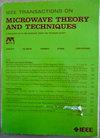基于扩展因子增强时域谱元求解器的 GaN HEMT 电热模拟
IF 4.1
1区 工程技术
Q2 ENGINEERING, ELECTRICAL & ELECTRONIC
IEEE Transactions on Microwave Theory and Techniques
Pub Date : 2024-08-21
DOI:10.1109/TMTT.2024.3441541
引用次数: 0
摘要
本文章由计算机程序翻译,如有差异,请以英文原文为准。
Electro-Thermal Simulation of GaN HEMT Based on a Scaling-Factor-Enhanced Time-Domain Spectral Element Solver
This article proposes a high-precision simulation method for transient electro-thermal coupling to characterize the self-heating effect in gallium nitride high electron mobility transistors (GaN HEMTs). The method is based on governing coupled drift-diffusion and heat conduction equations. A time scaling factor is introduced for the first time to accelerate the simulation process of electro-thermal coupling in GaN HEMTs. The technique addresses the cross-scale issue associated with the electrical and thermal response times encountered during the solution of the nonlinear coupling equations for GaN HEMTs. An accurate spectral element time-domain (SETD) method was utilized for the numerical realization of the nonlinear equations. The selection rules for the time scaling factor are discussed and exemplified through numerical simulations. By compared with commercial software, the advantages of the proposed method are demonstrated in terms of efficiency, accuracy, and random access memory (RAM) requirements. Based on its ability to accurately take into account electro-thermal coupling, this technique represents a powerful simulation tool for the design of high-performance devices and heat management.
求助全文
通过发布文献求助,成功后即可免费获取论文全文。
去求助
来源期刊

IEEE Transactions on Microwave Theory and Techniques
工程技术-工程:电子与电气
CiteScore
8.60
自引率
18.60%
发文量
486
审稿时长
6 months
期刊介绍:
The IEEE Transactions on Microwave Theory and Techniques focuses on that part of engineering and theory associated with microwave/millimeter-wave components, devices, circuits, and systems involving the generation, modulation, demodulation, control, transmission, and detection of microwave signals. This includes scientific, technical, and industrial, activities. Microwave theory and techniques relates to electromagnetic waves usually in the frequency region between a few MHz and a THz; other spectral regions and wave types are included within the scope of the Society whenever basic microwave theory and techniques can yield useful results. Generally, this occurs in the theory of wave propagation in structures with dimensions comparable to a wavelength, and in the related techniques for analysis and design.
 求助内容:
求助内容: 应助结果提醒方式:
应助结果提醒方式:


